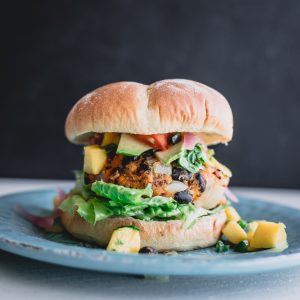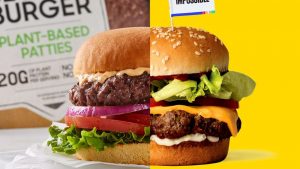In 2019, an average person in Canada consumed 70 kg of meat. The consumption amount decreased about 5% since 2000 with the increasing number of call-to-action to shift to a plant-based diet. However, even with the countless motivations of incorporating a vegan meal, many meat lovers are having difficulty cutting out meat from their diet.

A typical vegan burger
(Photo by Deryn Macey on Unsplash)
What Is So Great About Meat?
I want you to think about that question for a moment. Turns out there are many factors involved in making up the meat-eating experience.
First, let’s tackle the fundamental question: what is responsible for the distinct taste of meat?
Researchers at Impossible Foods, a company that makes plant-based meat, found that the taste of meat comes from an iron-containing molecule called heme. Heme exists in both plants and animals, and is carried by different kinds of protein (leghemoglobin and hemoglobin, respectively). By adding plant-sourced heme into their plant-based meat, Impossible Foods was able to reproduce the flavour of the meat without containing actual meat.
Watch this short video to find out more about heme, and how Impossible Foods produces heme efficiently and sustainably:

[Video: “Heme – the Magic Ingredient in the ImpossibleTM Burger” Credit: Impossible Foods]
Now we know where the taste of meat comes from, but you probably would agree that the experience of eating meat does not solely rely on its taste. The texture, colour, smell, and sizzling sound, all contribute to the pleasant experience of having meat – and no one said we cannot achieve these with plants.
A lot of research is happening to make the experience of having plant-based meat indistinguishable from having real meat. In addition to the items listed in the previous paragraph, researchers at Beyond Meat, a company that also makes plant-based meat, are making the nutritional content as close as possible to real ground beef.

Credit: Beyond Meat/Impossible Foods edited by Tehrene Firman
Making the Choice
As it was mentioned in the beginning, there are many reasons to choose a plant-based diet.
For animal welfare, “going vegan is one of the best things you can do to help stop animal cruelty” (Animal Aid). For climate change, studies showed that having a plant-based diet reduces the amount of greenhouse gas your actions produce. A vegan diet also saves resources such as land, water, and crops we feed to livestock animals. In fact, about one-third of arable land in the U.S. is being used to produce grain to feed livestock, corresponding to 70% of the grain grown in the country, enough to feed 800 million people.
In BC, you can find plant-based meat at grocery stores, or served at restaurants like Triple O’s and Burger King. An increase in demand means a decrease in price, and by simply replacing your regular burger with a plant-based burger, you are contributing to the environment.
So the next time you line up at the Triple O’s, think about ordering the plant-burger because you will enjoy the same meat-eating experience.
